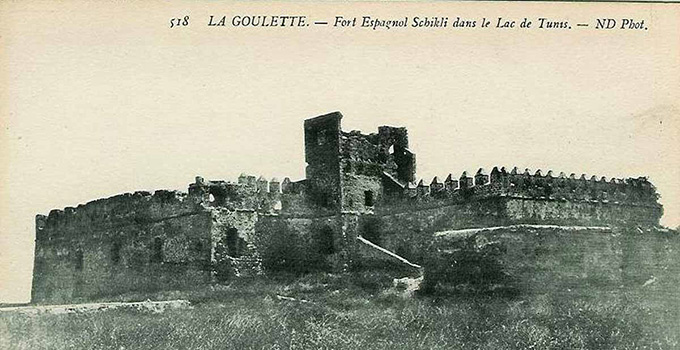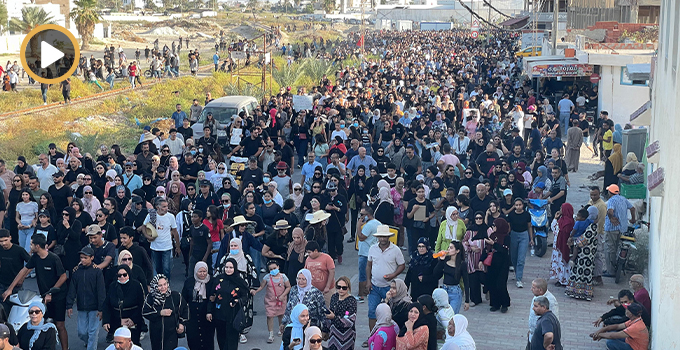
Chikly, a little island of 3.5 hectares, is a designated Natural Reserve owing to its ornithological richness as it is the nesting ground of the most important colony of Little Egrets (Egretta garzetta) in the north of Tunis. In addition to its natural appeal, the island has always been an alluring habitat for man as attested by the archeological remains of Phoenecian, Punic, Roman, Byzantian, Arab, Spanish, and Ottoman civilizations. Luzicon, Study Key for the Opening to the Public of the Fort of Santiago and Chikly
Chikly in Don Quixote

In the classic story of Don Quixote, Spanish novelist Miguel de Cervantes Saaveda, more simply known as Cervantes, refers to the islet of Chikly, «a small fort or tower which was in the middle of the lagoon under the command of Don Juan Zanoguera, a Valencian gentleman and famous soldier, capitulated upon terms (page 340, Don Quixote).» Unlike Cervantes’ novel, the island of Chikly is neither fictional, nor an idealized memory of the past; it endures today at the center of the Lake of Tunis, at once a thriving microcosm of flora and fauna that enshrines an ancient fort (formerly a fortress, garison and lazaret respectively), and little-remembered history, a natural and archeological marvel still largely absent from public awareness.
Although the island is located only ten minutes from the coast and connected to land by a little eight kilometers-long road, it was decided that access by boat be restricted in order to control the entry of visitors and to prevent damage to the heritage site where a guard keeps watch day and night. Preparations for the Opening of the Island of Chikly and Spanish Fort in Tunisia
Although it is national heritage site and natural reserve in plain view of the shores of Berges du Lac in Tunisia’s capital, the islet has never been officially open to Tunisians. Needless to say it is newsworthy—though curiously not in Tunisian media—that the recent completion of a study signals the imminent opening of the island to the public. A number of Spanish media outlets announced towards the end of last month the culmination of research work, carried out by a group from the Polytechnic University of Valencia (UPV), in the same vein of studies that the Tunisian National Heritage Institute (INP) proposed over a decade ago. A document detailing project objectives listed the need to develop «Recommendations within the current framework of Tunsian legislation for the creation of a management model for the realization of ecotourism at the Fort and Islet of Chikly… (Terms of Reference for the Elaboration of an Analysis of the Legal Framework for the Lake of Tunis and the Islet and Fort of Chikly (Tunis), National Heritage Institute (INP), 1991).”
In spite of the long lapse of time during which both the country’s legal framework and tourism industry have evolved beyond what anyone could have imagined at the early stages of Tunisian-Spanish collaborative work on the island, Chikly’s opening to the public is even more pertinent and valuable today to the country’s tourism industry, culture, and National Dialogue. In the midst of discourse and controversy surrounding Tunisia’s tourism sector, the completion of a project that represents an opportunity to draw visitors to the country is vital information to diffuse in national media or, at the very least, to have accessible on the websites of affiliated Tunisian ministries and institutions. On the contrary, Tunisian reports are both sparse and outdated, whereas a number of Spanish articles on the topic (of course only available in Spanish and English language) have recently cropped up online.
‘Chikly is present in Spanish literature and consciousness’
La isla de Chikly y su fuerte (Túnez) abrirán al público gracias a investigadoras en #Turismo de la @UPV http://t.co/Msaui75ECH #Gandia
— Campus de Gandia | UPV (@UPVCampusGandia) April 29, 2014
“The Island of Chikly and its fort (Tunisia) will open to the public thanks to researchers in #Turismo of the @UPV…”
Spanish reports on the opening of the island appeared towards the end of April, several among them published by various UPV outlets: «Tunis Will Open the Island of Chikly to the Public Thanks to a UPV Study» by the Network of Valencian Universities to Promote Research, Development, and Innovation (RUVID); the same article appears under the title «Chikly Island and Santiago Fort (Tunisia) Finalize Opening to the Public Thanks to a Study Realized by UPV Researchers» on the University’s main page; «Study Key to the Opening of Santiago Fort and Chikly Island» by the Center for the Support of Innovation, Research, and Technology Transfer describes the pertinence of the study as articulated by UPV researcher and wetlands expert María José Viñals—«The work carried out by the [Polytechnic] University of Valencia is the last step before opening this enclave to public visits.»
A Valencian news journal Lavangardia.com published a piece (replicated on Lainformacion.com) on «Preparations to Open the Island of Chikly and Spanish Fort in Tunisia» reporting that Viñals estimates the opening, which will be facilitated by the Spanish Agency for International Development Cooperation (AECID), to take place early in the Fall. Visitor capacity will be limited to twenty people per day, including ten for a guided excursion of island and ten for a tour of the fort; during the nesting season from March through June of each year, no visitors will be permitted on the island. According to Viñals, Tunisian students will also have the singular opportunity to explore the isle on educational fieldtrips: «…the Tunisian government is planning school visits within the context of promoting environmental education, but also promoting interest in ornithology, culture, and history.»
With a Dasguptian air of self-importance, an English-language article «Valencians Return to Defend Tunisia» on Valencia International spins its version of and stakes its claim in Chikly history:
Don Juan de Zamoguerra was a Valencian soldier who in 1574 was in charge of the defence of the Santiago fort of Chikly, situated in the middle of a lagoon, when the Turkish fleet prepared to wrest control of Tunisia from the Spanish forces led by Don Juan de Austria … Today the cannons have ceased to roar and the thousands who died in the defence of Spanish control of North Africa can enjoy the peace and quiet of the nature reserve that now occupies the same site. Valencians Return to Defend Tunisia, Valencia International.
Restoration, Research, Development: 1991 – Present
The restoration, research studies, and development planning for the island is attributed to a fairly convoluted web of (mostly non-Tunisian) organizations. According to RUVID, after the completion of a ten-year restoration process undertaken by the Polytechnic University of Madrid with the support of AECID, the island was deemed ready for visitors. The Culture and Wetlands of the Mediterranean project was initiated «to analyze the carrying apacity for recreation, management guidelines, and conservation standards» through funding by the MAVA Foundation in association with Med-INA‘s MedWet Initiative. The Research Group for Tourism Management of Cultural and Natural Heritage of the UPV, under the supervision of the General Directorate of Forestry and the support of the Spanish Embassy in Tunis, was assigned the task of carrying out the study to the effect of creating «a proposal for interpretative activities compatible with the conservation of the natural environment and of the fort, establishing guidelines for the maintenance and operation and standards for environmental, cultural, and social conservation that will be able to be monitored by the state.»
Tunisian Media on Chikly
It is a history destroyed and rebuilt. Now is the time for rebuilding. And this fort, whose connotation was once one of military and defense, can today only represent openness, tolerance, and dialogue. Zohra Abid, The Island of Chikly: The Fort of Dialogue and Fraternity
The most recent reports on Chikly in Tunisian media, published in or around 2010, are several romantic accounts of what Tunisians, by no fault of their own, fail to recognize as they gaze across the Lake. The lofty undertaking of renovation work inspired nostalgic descriptions of Chikly’s past significance and optimistic visions of its future value as a national heritage site, a potential avenue of ecotourism and symbol of auspicious Tunisia-Spain collaborations. The most thorough and informative article, “These Mysterious Islands” on La Presse de Tunisie offers a glimpse into the island’s history and biodiversity. Another piece from Le Quotidien noted what resonates today–«Chikly is present in Spanish literature and conscience,»–as still such awareness does not seem to have touched Tunisian society. Whereas the primary Tunisian institutions concerned with Chikly projects—namely the Ministry of Culture, the National Heritage Institute (INP), and the General Directorate for Forestry—have yet to respond to Nawaat’s request for details, María José Viñals of UPV has been a prompt and accessible resource for our questions about Chikly affaires. Asked why Tunisian authorities had made no allusion to the UPV research study and purportedly imminent opening of the island, Viñals explained that, «Indeed, there is not much information available to the public because authorization by the Ministry of Culture is currently pending» and that «regarding the opening in Autumn, I believe this depends on how quickly permits are processed. If there is interest on the part of the authorities responsible, especially the General Forestry Directorate, this can happen sooner.»
Bringing Chikly into the Public Conscience and National Discourse
…the proposal for a learning center of the Lake of Tunis was launched with the objective of presenting to the public the historical, cultural, and natural importance of the site and to develop a tour of ecological and cultural interest. A tour circuit will be made in efforts to share the history, at once rich and complex, of the restoration of the Lake, the Island, and the Fort, but also and above all, to enable visitors to discover the historical relations between the Lake of Tunis, the Medina, and the progressive urbanization of the city of Tunis. Terms of Reference for the Elaboration of an Analysis of the Legal Framework for the Lake of Tunis and the Islet and Fort of Chikly (Tunis)
Chikly is a story that remains largely untold in Tunisia, still holding a place somewhere on the Ministry of Culture’s dusty bookshelves, waiting to be pulled out and discovered by Tunisians and tourists alike, although it is relevant now—even more than three decades ago when Tunisian, Spanish, and international institutions set to work to protect, preserve, and make known the island—to infuse the politics and polemics of the country’s National Dialogue with discourse on Tunisia’s unique historical, cultural, and natural features and new, promising prospects for ecotourism.



[…] environmental offerings, represent a strong pull for foreign investors from Austria, Indonesia, and Spain in the exploration and production of hydrocarbons, desalination of sea water for consumption, and […]
[…] and is owned by Ministry of Culture of Tunisia. To date, the fort is being restored as part of the Tunisian-Spanish cooperation involving the National Heritage Institute and the University of Madrid. Excavation and cleaning […]